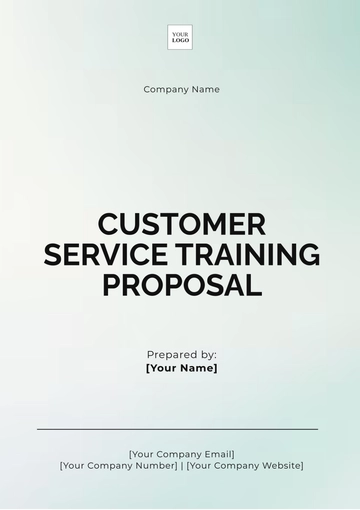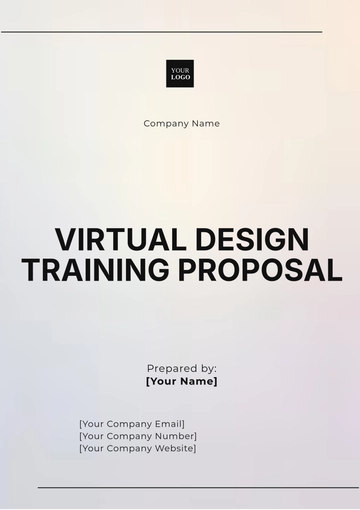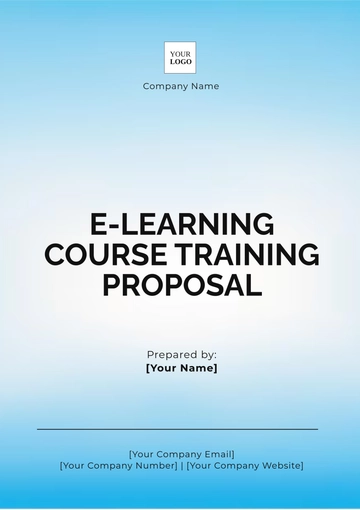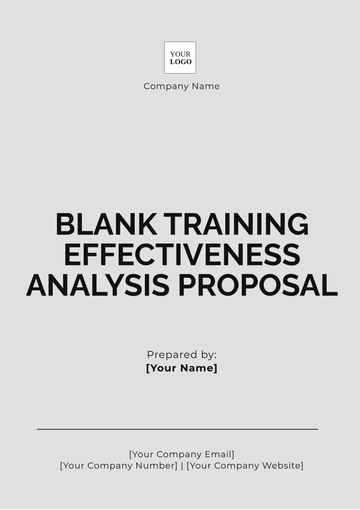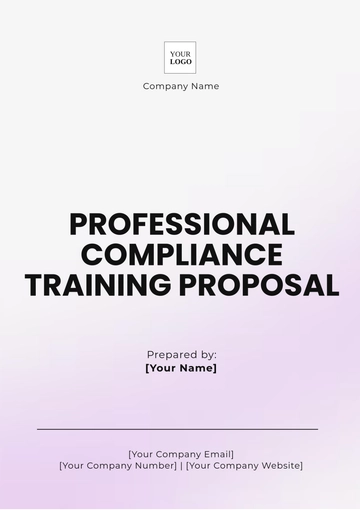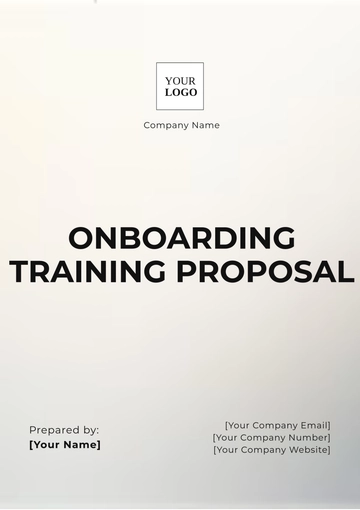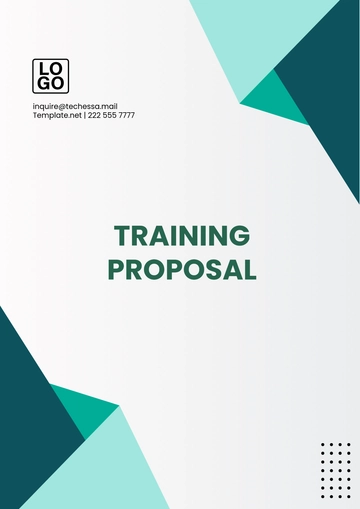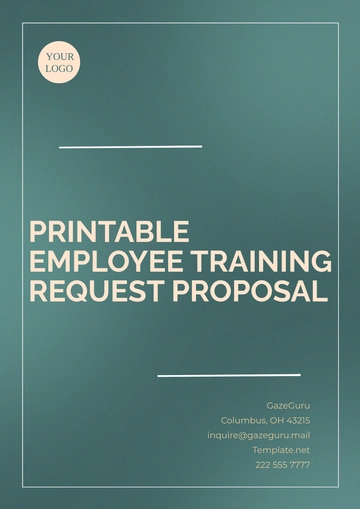Free School Training Proposal

I. Executive Summary
The purpose of this training proposal is to outline a comprehensive training program designed to enhance the skills and knowledge of school staff at [Your Company Name]. This initiative is aimed at improving the overall quality of education and administrative efficiency within the school. The training program will cover various aspects including instructional strategies, technology integration, and administrative skills.
The total budget for this training program is estimated at $20,000. This budget will cover training materials, professional trainers, and logistical expenses. The program will be implemented over a period of 6 months, with regular evaluations to ensure its effectiveness and relevance to the school's needs.
By investing in this training program, [Your Company Name] aims to foster a culture of continuous improvement and professional development among its staff. This will ultimately lead to better educational outcomes for students and a more effective and cohesive school environment.
II. Training Objectives
A. Improve Instructional Strategies
Enhance Teaching Techniques: Provide teachers with advanced methods and strategies to improve student engagement and learning outcomes. This includes differentiated instruction and active learning approaches.
Assessment and Evaluation: Train teachers in effective assessment and evaluation techniques to better understand student progress and areas needing improvement.
Classroom Management: Equip teachers with skills to manage classroom behavior effectively, creating a conducive learning environment.
Special Education: Provide specialized training for teachers to support students with special needs, ensuring inclusive education practices.
Curriculum Development: Assist teachers in developing and adapting curriculum to meet the diverse needs of students and align with educational standards.
B. Integrate Technology in Education
Digital Literacy: Enhance teachers' and administrative staff's digital literacy to effectively use technology in teaching and school management.
E-Learning Tools: Train staff on the use of various e-learning tools and platforms to facilitate remote and blended learning.
Data Management: Provide training on data management systems to streamline administrative processes and improve data-driven decision-making.
Cybersecurity: Educate staff on cybersecurity practices to protect sensitive information and maintain data privacy.
C. Enhance Administrative Skills
Leadership Training: Develop leadership skills among school administrators to foster a positive school culture and effective management.
Conflict Resolution: Train staff in conflict resolution techniques to handle disputes and create a harmonious work environment.
Time Management: Equip staff with time management skills to enhance productivity and efficiency in their roles.
Financial Management: Provide training on budgeting, financial planning, and resource allocation to improve the school's financial health.
Communication Skills: Enhance communication skills among staff to improve collaboration and interaction with students, parents, and colleagues.
III. Training Schedule
The following table outlines the proposed training schedule, including the training topics, duration, and key dates. This schedule is designed to ensure comprehensive coverage of all essential areas within a manageable timeframe:
Training Topic | Duration | Key Dates |
|---|---|---|
Instructional Strategies | 2 months | July - August |
Technology Integration | 1 month | September |
Administrative Skills | 2 months | October - November |
Evaluation and Feedback | 1 month | December |
A. Instructional Strategies
July - August: The focus will be on enhancing teaching techniques, classroom management, and curriculum development. Training sessions will include workshops, seminars, and practical demonstrations.
Session Highlights: Teachers will engage in role-playing and peer reviews to practice new strategies. They will also receive feedback from experienced educators.
Expected Outcomes: By the end of this period, teachers should be able to implement new instructional techniques confidently and effectively manage their classrooms.
B. Technology Integration
September: This month will be dedicated to improving digital literacy and familiarizing staff with e-learning tools and data management systems.
Hands-On Training: Staff will participate in hands-on sessions where they will learn to use various software and platforms essential for modern education.
Implementation: By the end of September, staff should be able to incorporate technology seamlessly into their daily routines and enhance the learning experience for students.
C. Administrative Skills
October - November: Focus on leadership, conflict resolution, time management, financial management, and communication skills.
Interactive Workshops: Sessions will include interactive workshops, group discussions, and case studies to provide practical knowledge and skills.
Leadership Development: Administrators will undergo specific training to enhance their leadership capabilities and foster a positive school culture.
D. Evaluation and Feedback
December: The final month will focus on evaluating the effectiveness of the training program and gathering feedback from participants.
Assessment Methods: Various assessment methods, including surveys, interviews, and performance reviews, will be used to gauge the impact of the training.
Continuous Improvement: The feedback will be used to make necessary adjustments and improvements to future training programs.
The comprehensive training schedule ensures that all critical areas are covered thoroughly. By spreading the training over six months, it allows staff to assimilate and apply the new skills effectively, ensuring a lasting impact on the school's overall performance.
IV. Training Content
A. Instructional Strategies
Active Learning: Focus on active learning techniques that engage students and promote critical thinking. This includes collaborative learning, problem-based learning, and inquiry-based learning.
Differentiated Instruction: Train teachers in differentiated instruction methods to cater to the diverse learning needs of students. This ensures that all students receive the support they need to succeed.
Formative Assessment: Emphasize the importance of formative assessment in guiding instruction and providing feedback to students. This helps in identifying learning gaps and adjusting teaching methods accordingly.
Project-Based Learning: Introduce project-based learning as a way to integrate real-world applications into the curriculum. This enhances student engagement and fosters deeper learning.
Culturally Responsive Teaching: Train teachers in culturally responsive teaching practices to create inclusive and equitable learning environments. This ensures that all students feel valued and supported.
B. Technology Integration
Blended Learning: Explore blended learning models that combine traditional classroom instruction with online learning. This provides flexibility and enhances the learning experience.
Digital Tools: Introduce a range of digital tools and resources that can be used to enhance teaching and learning. This includes educational apps, online platforms, and interactive software.
Flipped Classroom: Train teachers on the flipped classroom model, where students engage with instructional content at home and use classroom time for interactive activities. This promotes active learning and student engagement.
Data Analytics: Provide training on using data analytics to monitor student progress and inform instructional decisions. This helps in identifying trends and making data-driven decisions.
C. Administrative Skills
Strategic Planning: Develop strategic planning skills among school administrators to set clear goals and objectives for the school. This ensures a focused and coherent approach to school improvement.
Performance Management: Train administrators in performance management techniques to evaluate and support staff effectively. This helps in fostering a culture of continuous improvement and accountability.
Resource Allocation: Provide training on effective resource allocation to ensure that the school’s financial and human resources are used efficiently. This maximizes the impact of available resources.
Crisis Management: Equip administrators with crisis management skills to handle emergencies and unexpected situations effectively. This ensures the safety and well-being of students and staff.
Stakeholder Engagement: Train administrators in stakeholder engagement techniques to build strong relationships with parents, community members, and other stakeholders. This enhances community support and involvement.
D. Evaluation Techniques
Formative Assessment: Emphasize the use of formative assessment to guide instruction and provide feedback to students. This helps in identifying learning gaps and adjusting teaching methods accordingly.
Summative Assessment: Train teachers in designing and implementing effective summative assessments to evaluate student learning at the end of instructional units. This provides a comprehensive understanding of student progress.
Self-Assessment: Introduce self-assessment techniques for students to reflect on their own learning and set personal goals. This encourages self-directed learning and accountability.
Peer Assessment: Train teachers on the use of peer assessment to promote collaborative learning and critical thinking. This provides students with opportunities to give and receive feedback from their peers.
Rubrics: Provide training on the development and use of rubrics to ensure consistent and objective assessment of student work. This enhances transparency and fairness in grading.
The training content is designed to cover a wide range of areas essential for effective teaching, technology integration, and administrative efficiency. By focusing on these key areas, the training program aims to equip staff with the knowledge and skills needed to enhance the overall quality of education and school management. Each section of the training content is carefully selected to address specific needs and ensure comprehensive professional development for all staff members.
V. Budget and Resources
The following chart and table provide the detailed breakdown of the budget for the training program. Each category is carefully allocated to ensure all necessary expenses are covered while maintaining financial efficiency:
Category | Estimated Cost |
|---|---|
Training Materials | $3,000 |
Professional Trainers | $10,000 |
Venue and Logistics | $2,500 |
Technology and Equipment | $2,000 |
Miscellaneous Expenses | $2,500 |
Total | $20,000 |
A. Training Materials
Books and Manuals: Purchase of instructional books and training manuals tailored to the specific needs of the training program. These resources will provide valuable reference material for staff.
Workbooks: Custom workbooks will be created to facilitate interactive learning and practical application of new skills during training sessions.
Digital Resources: Acquisition of digital resources, including e-books and online training modules, to supplement traditional training materials.
B. Professional Trainers
Hiring Experts: Engage experienced trainers with expertise in education, technology, and administration to conduct the training sessions. Their knowledge and experience will be instrumental in delivering high-quality training.
Guest Speakers: Invite guest speakers for special sessions to provide unique insights and real-world perspectives. This will enrich the training experience for participants.
Trainer Fees: Allocate a significant portion of the budget to cover the fees of professional trainers, ensuring that we attract top-tier talent for the training program.
C. Venue and Logistics
Training Venues: Secure appropriate venues for training sessions, ensuring they are equipped with necessary facilities and conducive to learning.
Logistical Support: Provide logistical support, including transportation and accommodation for trainers if necessary. This ensures smooth execution of the training sessions.
Refreshments: Offer refreshments during training sessions to keep participants energized and engaged.
D. Technology and Equipment
Hardware: Purchase necessary hardware, such as laptops and projectors, to facilitate the training sessions. This equipment will be essential for technology integration training.
Software: Invest in relevant software and licenses required for training on e-learning tools and data management systems.
Maintenance: Allocate funds for the maintenance and upgrade of training equipment to ensure it remains functional and up-to-date.
E. Miscellaneous Expenses
Contingency Fund: Set aside a contingency fund to cover any unforeseen expenses that may arise during the training program. This ensures financial flexibility and preparedness.
Additional Supplies: Purchase additional supplies, such as stationery and printing materials, to support the training sessions.
Unexpected Costs: Address any unexpected costs that may occur, ensuring the training program runs smoothly without financial constraints.
The budget breakdown ensures that all aspects of the training program are adequately funded. By allocating resources to training materials, professional trainers, venue logistics, and technology, we can provide a comprehensive and effective training experience. The inclusion of a contingency fund allows for flexibility in managing unforeseen expenses, ensuring the program's success.
VI. Training Methodologies
A. Workshops
Interactive Sessions: Conduct interactive workshops that allow participants to engage in hands-on activities and practical exercises. This approach facilitates active learning and skill development.
Group Work: Incorporate group work and collaborative projects into workshops to foster teamwork and peer learning. This helps participants learn from each other’s experiences and perspectives.
Case Studies: Use real-world case studies to provide practical examples and stimulate critical thinking. This enables participants to apply theoretical knowledge to real-life situations.
Role-Playing: Include role-playing exercises to help participants practice and refine their skills in a controlled environment. This enhances their confidence and competence.
Feedback and Reflection: Allocate time for feedback and reflection during workshops to help participants evaluate their progress and identify areas for improvement.
B. Seminars
Expert Lectures: Organize seminars featuring expert lectures on various topics relevant to the training program. This provides participants with access to advanced knowledge and insights.
Panel Discussions: Host panel discussions with industry experts and experienced educators to explore different perspectives and approaches. This encourages critical thinking and broadens participants’ understanding.
Q&A Sessions: Include Q&A sessions in seminars to allow participants to ask questions and engage with speakers. This facilitates knowledge exchange and clarification.
Networking Opportunities: Provide opportunities for participants to network with speakers and peers during seminars. This helps build professional relationships and encourages collaboration.
C. Online Training
E-Learning Modules: Develop e-learning modules that participants can complete at their own pace. This provides flexibility and convenience for staff with varying schedules.
Webinars: Conduct live webinars to deliver training content and allow for real-time interaction. This combines the benefits of online learning with the engagement of live sessions.
Online Assessments: Use online assessments to evaluate participants’ understanding and progress. This helps identify areas needing further attention and improvement.
Resource Library: Create an online resource library with training materials, recorded sessions, and supplementary resources. This provides ongoing access to valuable information and support.
D. Peer Learning
Mentorship Programs: Establish mentorship programs where experienced staff mentor their peers. This promotes knowledge sharing and professional growth.
Peer Reviews: Implement peer review sessions where participants can give and receive constructive feedback on their practices. This fosters a culture of continuous improvement.
Collaborative Projects: Encourage collaborative projects where staff work together to solve problems and develop new strategies. This enhances teamwork and collective learning.
Discussion Forums: Create discussion forums for participants to share ideas, experiences, and challenges. This builds a supportive learning community.
The use of diverse training methodologies ensures that the program caters to different learning styles and preferences. Interactive workshops, expert-led seminars, and flexible online training provide a well-rounded approach to professional development. Peer learning initiatives foster a collaborative and supportive environment, enhancing the overall effectiveness of the training program.
VII. Evaluation and Feedback
The following table outlines the criteria for pre-training assessment to understand the current skills and knowledge levels of the staff:
Criteria | Description |
|---|---|
Skill Assessment | Evaluation of current skill levels in key areas |
Knowledge Test | Test of existing knowledge related to training topics |
Self-Evaluation | Participants' self-assessment of their strengths and weaknesses |
Feedback Collection | Gathering initial feedback on training needs and expectations |
A. Skill Assessment
Baseline Evaluation: Conduct a baseline evaluation to determine the current skill levels of participants. This provides a reference point for measuring progress.
Customized Assessments: Use customized assessments tailored to the specific roles and responsibilities of staff. This ensures relevance and accuracy in measuring skills.
Evaluation Tools: Employ various evaluation tools, including tests, practical exercises, and observations, to assess skills comprehensively.
B. Knowledge Test
Content-Specific Tests: Administer tests focused on the specific content areas of the training program. This helps identify gaps in knowledge and areas needing improvement.
Periodic Testing: Conduct periodic tests throughout the training program to monitor progress and adjust training as needed. This ensures continuous learning and improvement.
Feedback Reports: Provide detailed feedback reports to participants, highlighting their strengths and areas for improvement. This helps guide their learning journey.
C. Self-Evaluation
Reflection Exercises: Incorporate reflection exercises where participants assess their own strengths and weaknesses. This encourages self-awareness and personal growth.
Goal Setting: Encourage participants to set personal learning goals based on their self-evaluations. This fosters motivation and a sense of ownership in the learning process.
Regular Check-Ins: Schedule regular check-ins with participants to discuss their progress and adjust goals as needed. This provides ongoing support and guidance.
D. Feedback Collection
Initial Surveys: Distribute initial surveys to gather feedback on training needs and expectations from participants. This helps tailor the training program to meet their specific needs.
Focus Groups: Conduct focus groups to gain deeper insights into participants’ expectations and preferences. This provides valuable qualitative data to inform training design.
Ongoing Feedback: Establish mechanisms for ongoing feedback throughout the training program. This allows for continuous improvement and responsiveness to participants’ needs.
The pre-training assessment ensures that the training program is tailored to the specific needs and current levels of the staff. By understanding their strengths and areas for improvement, we can design a program that maximizes learning and development. Regular evaluations and feedback collection ensure that the training remains relevant and effective, leading to meaningful professional growth for all participants.
VIII. Implementation Plan
A. Preparation Phase
Needs Assessment: Conduct a thorough needs assessment to identify the specific training requirements of the staff. This involves gathering input from teachers, administrators, and other stakeholders.
Training Design: Develop a detailed training plan based on the needs assessment. This includes defining objectives, selecting training methods, and creating training materials.
Resource Allocation: Allocate the necessary resources, including budget, trainers, and materials, to support the training program. This ensures that all aspects of the program are adequately funded and equipped.
Scheduling: Develop a training schedule that accommodates the availability of staff and minimizes disruption to regular school activities. This ensures that training sessions are well-attended and effective.
B. Training Delivery
Kick-Off Meeting: Hold a kick-off meeting to introduce the training program and outline its objectives, schedule, and expectations. This sets the tone for the training and engages participants from the start.
Training Sessions: Deliver the training sessions as per the schedule, using a mix of workshops, seminars, online training, and peer learning. This ensures a comprehensive and engaging learning experience.
Ongoing Support: Provide ongoing support to participants throughout the training program. This includes access to resources, one-on-one coaching, and opportunities for feedback and discussion.
Progress Monitoring: Monitor the progress of participants through regular assessments and feedback. This helps in identifying any challenges and making necessary adjustments to the training plan.
C. Post-Training Phase
Evaluation: Conduct a thorough evaluation of the training program to assess its effectiveness and impact. This involves gathering feedback from participants and analyzing assessment results.
Follow-Up: Provide follow-up support to ensure that participants can apply their new skills and knowledge effectively. This includes additional coaching, resources, and opportunities for continued learning.
Reporting: Prepare a comprehensive report on the training program, detailing its outcomes, successes, and areas for improvement. This provides valuable insights for future training initiatives.
Continuous Improvement: Use the evaluation results to make continuous improvements to the training program. This ensures that future training efforts are even more effective and aligned with the needs of the school.
The implementation plan outlines the steps necessary to ensure the successful execution of the training program. By focusing on thorough preparation, effective delivery, and comprehensive follow-up, we can maximize the impact of the training and achieve the desired outcomes. The plan also emphasizes the importance of continuous improvement, ensuring that the training program evolves and remains relevant to the needs of the staff and the school.
IX. Conclusion and Next Steps
A. Conclusion
This School Training Proposal of [Your Company Name] is designed to provide comprehensive professional development for all school staff. By focusing on improving instructional strategies, integrating technology, enhancing administrative skills, and utilizing effective evaluation techniques, the training program aims to elevate the overall quality of education and school management. The detailed implementation plan ensures that the training is delivered effectively and that participants receive ongoing support and follow-up to apply their new skills and knowledge.
Investing in this training program demonstrates [Your Company Name]’s commitment to continuous improvement and excellence in education. By equipping staff with the necessary tools and skills, we can create a positive and impactful learning environment for students and a more efficient and cohesive school community. The success of this training program will ultimately lead to better educational outcomes and a stronger, more effective school.
B. Next Steps
The following steps outline the immediate actions required to move forward with the training program:
Approval and Funding: Secure approval and funding for the training program from the relevant stakeholders. This includes finalizing the budget and ensuring that all necessary resources are allocated.
Needs Assessment: Conduct a comprehensive needs assessment to identify the specific training requirements of the staff. This will inform the design and content of the training program.
Training Design: Develop a detailed training plan, including objectives, methods, and materials. This involves collaboration with trainers and subject matter experts to ensure the program’s relevance and effectiveness.
Scheduling and Logistics: Create a training schedule that accommodates the availability of staff and minimizes disruption to school activities. Arrange for venues, trainers, and materials needed for the training sessions.
Kick-Off Meeting: Hold a kick-off meeting to introduce the training program to all participants, outlining its objectives, schedule, and expectations. This will engage and motivate participants from the start.
By following these steps, we can ensure a smooth and effective launch of the training program. The focus on thorough preparation, clear communication, and continuous support will contribute to the program’s success and the achievement of its goals.
- 100% Customizable, free editor
- Access 1 Million+ Templates, photo’s & graphics
- Download or share as a template
- Click and replace photos, graphics, text, backgrounds
- Resize, crop, AI write & more
- Access advanced editor
Propose training programs with the School Training Proposal Template! Available only on Template.net, this template is fully customizable to suit different training needs. Its editable format ensures you can make detailed adjustments. The AI Editor Tool helps you create professional and convincing proposals, ensuring that your training initiatives are well-presented!
You may also like
- Business Proposal
- Research Proposal
- Proposal Request
- Project Proposal
- Grant Proposal
- Photography Proposal
- Job Proposal
- Budget Proposal
- Marketing Proposal
- Branding Proposal
- Advertising Proposal
- Sales Proposal
- Startup Proposal
- Event Proposal
- Creative Proposal
- Restaurant Proposal
- Blank Proposal
- One Page Proposal
- Proposal Report
- IT Proposal
- Non Profit Proposal
- Training Proposal
- Construction Proposal
- School Proposal
- Cleaning Proposal
- Contract Proposal
- HR Proposal
- Travel Agency Proposal
- Small Business Proposal
- Investment Proposal
- Bid Proposal
- Retail Business Proposal
- Sponsorship Proposal
- Academic Proposal
- Partnership Proposal
- Work Proposal
- Agency Proposal
- University Proposal
- Accounting Proposal
- Real Estate Proposal
- Hotel Proposal
- Product Proposal
- Advertising Agency Proposal
- Development Proposal
- Loan Proposal
- Website Proposal
- Nursing Home Proposal
- Financial Proposal
- Salon Proposal
- Freelancer Proposal
- Funding Proposal
- Work from Home Proposal
- Company Proposal
- Consulting Proposal
- Educational Proposal
- Construction Bid Proposal
- Interior Design Proposal
- New Product Proposal
- Sports Proposal
- Corporate Proposal
- Food Proposal
- Property Proposal
- Maintenance Proposal
- Purchase Proposal
- Rental Proposal
- Recruitment Proposal
- Social Media Proposal
- Travel Proposal
- Trip Proposal
- Software Proposal
- Conference Proposal
- Graphic Design Proposal
- Law Firm Proposal
- Medical Proposal
- Music Proposal
- Pricing Proposal
- SEO Proposal
- Strategy Proposal
- Technical Proposal
- Coaching Proposal
- Ecommerce Proposal
- Fundraising Proposal
- Landscaping Proposal
- Charity Proposal
- Contractor Proposal
- Exhibition Proposal
- Art Proposal
- Mobile Proposal
- Equipment Proposal
- Student Proposal
- Engineering Proposal
- Business Proposal


